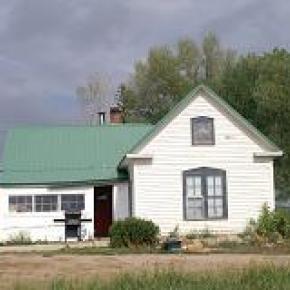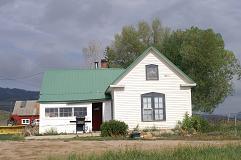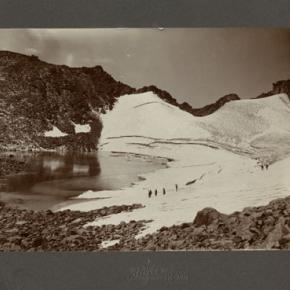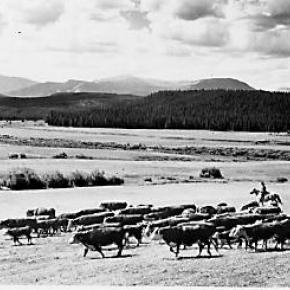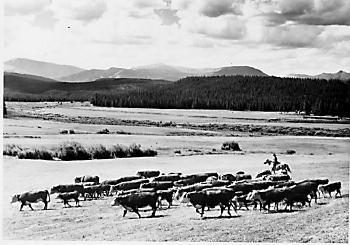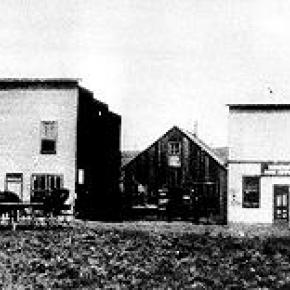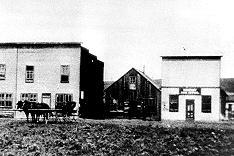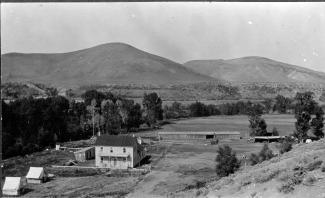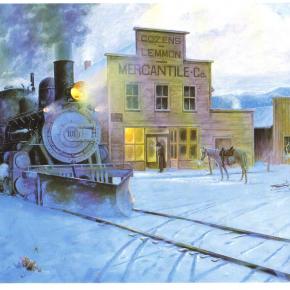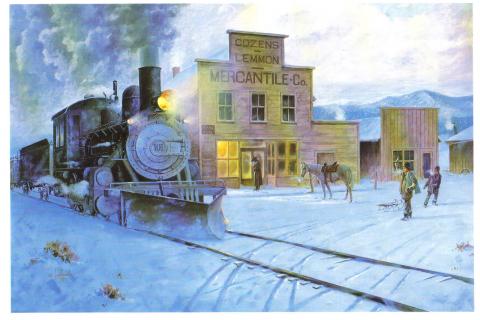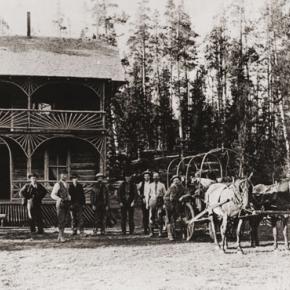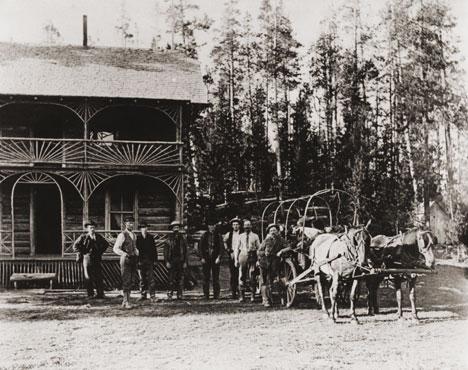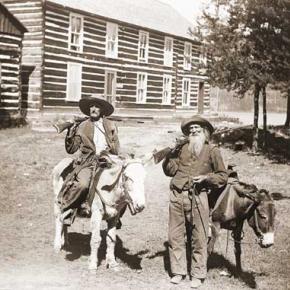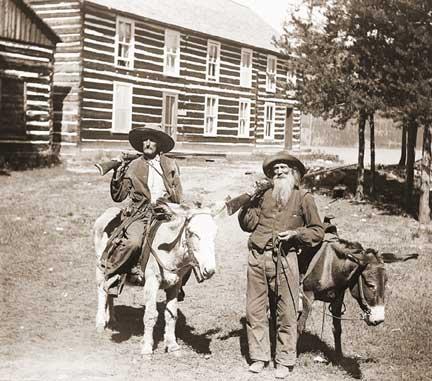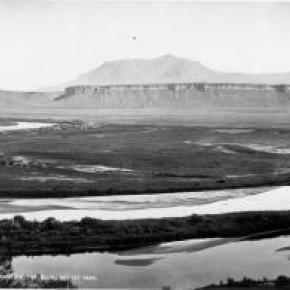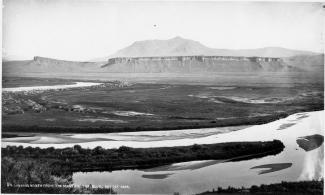People Articles
| Ute Legends of Hot Sulphur Springs |
Ute Legends of Hot Sulphur Springs

Ages ago, there were many Ute Indians who enjoyed life in Middle Park with its plentiful game and lush meadows. They lived in peace and harmony for "as many years as there are hairs on the head." In spite of this idyllic life, there was one young brave who yearned for more adventure and material goods. He proposed that the Utes attack the Sioux, who lived beyond the mountains on the plains of the rising sun. As victors, they would return in glory with much wealth and many captives. Spiquet Pah (Smoking Water) was an elderly medicine man who foresaw only grief in the prospect of such a war. He spoke before a council meeting, warning of the devastation that such an action would bring upon the tribe. He foretold " As the North Wind soon brings the snows and death of winter, so will he bring sorrow and death to our own people.....if you do this, strength and peace and plenty will be but for a few; joy will be seen no more." Disregarding his warning, most of the young men were tantalized with the temptation of the grand adventure of such a conquest. In the autumn of the year, when they usually did their hunting, the young men rallied behind the young brave and followed him over the Great Divide into combat with the plains people. As the fighters departed, a saddened Spiquet Pah went into the heart of the mountain "and pulled the hole in after him." The young Ute men found the enemy better armed and organized than they expected. Many Ute braves were killed and others were taken as slaves. The prophecy had come true as starvation and disease plagued the tribe as there were too few men to hunt for food. The old man sat on his haunches beside his subterranean fire which he heated water from an underground stream. From the mountain at Hot Sulphur Springs, water flows even today as a reminder of the rash behavior of so long ago. Another legend holds simply that the Hot Sulphur Springs water acquired medicinal qualities in answer to the prayers of an old chief who has be left by his tribe to die. The old man built fires within the mountain, and after drinking the water and bathing in them, we was restored to health and rejoined his people. |
| Video: Betty Birdsill & Maryan Pharo Part 1 |
Video: Betty Birdsill & Maryan Pharo Part 1
The Voices of Middle Park Project is up and running! If you are interested in helping to capture the living history of Grand County through videos or audio interviews….or if you have a potential interviewee in mind, Contact Dede Fay at 970-531-7020 for more information. Watch an interview with Betty Birdsill and Maryan Pharo |
| Video: Betty Birdsill & Maryan Pharo Part 2 |
|
| Wheatley Family of the Troublesome |
Wheatley Family of the Troublesome

Forrest Wheatley was born in Chicago in 1875 and his brother George R. was born 6 years later. Their parents were English immigrants, William and Mary. The family moved to Denver in 1887 where William pursued his trade of upholstering carriages. After Forrest returned from service in the Spanish American War in 1900, he and George decided to establish homesteads of 160 acres each on the East Fork of Troublesome Creek. When the expansion of the National Forest land limited the growth of their holdings, they moved to Muddy Creek to the west and ran their operation there until 1929. They continued to purchase additional homesteads on the Troublesome. The brothers had a disagreement so Forrest and his wife Ida remained on the Muddy while George moved back to the Troublesome. He sold the original claims high on the East Fork. Later he married his neighbor, Bessie Sampson, and they moved back to the Muddy Creek basin and had five children; George, Douglass, Kenneth, Maidie and Gene. Gene drowned in an irrigation ditch while still a young child. Through purchases and marriages, the Wheatley descendents eventually owned property throughout western Grand County and as far north as the Yampa River Valley. |
| William Byers |
William Byers
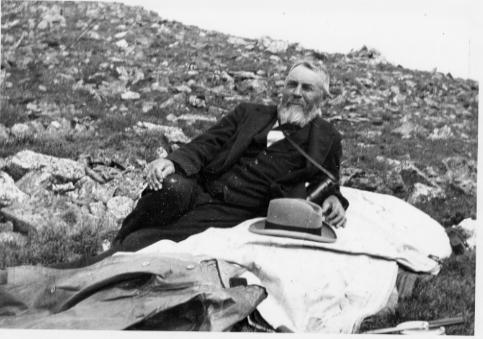
Article contributed by Abbott Fay Born in Ohio in 1831, William Byers became a surveyor in Iowa, Nebraska, Oregon and Washington during the 1850's. He described himself later as "a mountain tramp". In 1859, he hauled a printing press to the new town of Denver, where he founded the Rocky Mountain News. He also served as postmaster of the settlement. He was enthusiastic about the mining prospects of Colorado, and wrote endless editorials about the wealth to be found in the mountains to the West. However, many disappointed prospectors took to referring to Byers newspaper as the "Rocky Mountain Liar". Among his promotions was the idea that the South Platte River could be made navigable. That vision never became reality due to the size of the river. He wrote inflammatory articles against Indians which contributed to the infamous Sand Creek Massacre, a slaughter of peaceful natives by Colorado militia in 1864. Fascinated by the co-called "boiling springs" in Middle Park, Byers managed to obtain rudimentary land titles from Indian claimants and promoters to establish the town of Hot Sulphur Springs in 1863. Byers developed Hot Sulphur Springs into what was probably Colorado's first resort town. He also tried to grow grapes and other commercial garden crops in Grand County, with little or no success. He invested in sawmills and was part owner with William Cozens of the Hilry Harry & Company "Brand H" ranch. In 1901, at the age of 70, Byers undertook the ascent of the peak which had been named for him by the official Hayden survey. The next year he donated land for the Grand County Courthouse in Hot Sulphur Springs William Byers died in 1903. His fame is preserved in the names of Byers Canyon, Byers Peak and the town of Byers. He was one of the founders of the Colorado Historical Society, which owns the Byers-Evans House, a historical museum in Denver. There is a stained glass window of his portrait in the Colorado State Capitol building. Sources: Don and Jean Griswold, Colorado's Century of Cities, Denver CO 1958. Thomas J. Noel, The Colorado Almanac, Portland, OR 2001 Samuel Bowles, The Switzerland of America, Springfield, MA, 1869 Robert C. Black, Island in Rockies, Boulder CO, 1968 Lulita Pritchett, Maggie By My Side, Steamboat Springs CO, 1976 Dougall MacDonald, Long's Peak: Colorado's Favorite Fourteener, Englewood CO, 2004 Carl Ubbelokdre, Maxine Benson and Duane Smith, A Colorado History, Boulder CO 1972 Alice Reich and Thomas Steel, Fraser Haps and Mishaps, Denver CO 1990
|
| William H. Kimball |
William H. Kimball

The span crossing the Colorado River on State Highway 9 southeast of Kremmling is known as the Kimball Bridge. It honors the memory of William H. Kimball who carried the mail over Berthoud Pass from Empire to Hot Sulphur Springs by foot, winter and summer. Kimball was born in Maine and accepted the Middle Park mail contract in 1875. Although reportedly nearly blind, Kimball traveled on snowshoes all winter carrying a backpack of mail weighing 70-105 pounds, day and night, at least once a week. In 1884, Kimball established a flat bottom ferry over the Colorado River near the spot where the bridge now stands. Before that time, no wagons could cross at that area. With the addition of the ferry, load of game meat and fish could be taken up the Blue River to be traded for much needed staples. Kimball never married and lived at a nearby ranch until his death in 1909. |
- ‹ previous
- 7 of 7









